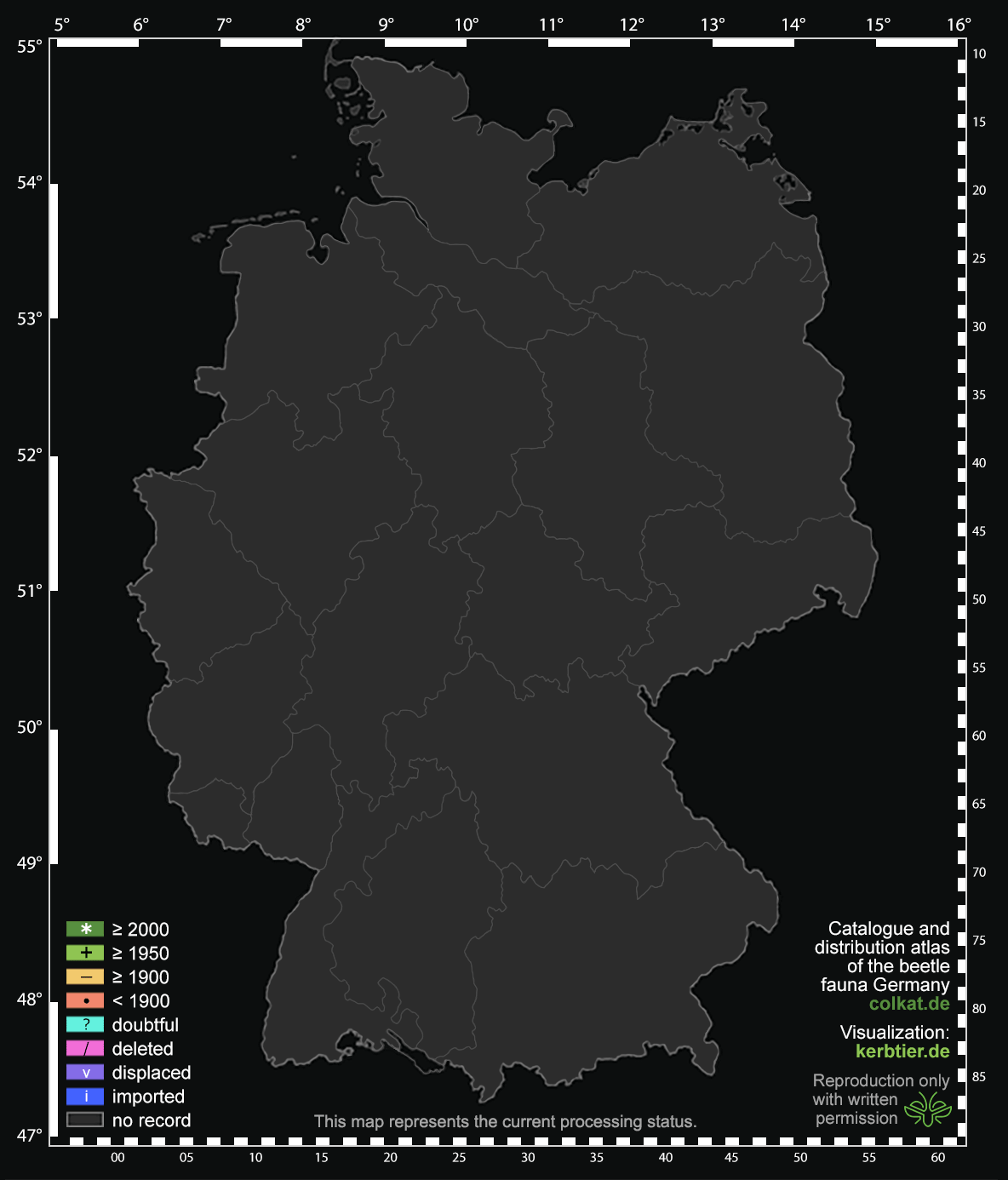View answered requests for beetle ID
|
|
On this page you can find photos submitted by users from the start in 2012 till the shutdown in 2023. If possible, the species are identified by the kerbtier.de ID team. Sometimes determination by photo only is impossible, in this case a hint on family and genus and potential species will be given.
|
|

|
|

|
|
|
|
|
|
|
|
Submitted by, on:
 518 518
 1 1

Appius  2015-03-27 16:31 2015-03-27 16:31

Country, map sheet, date (discovery):
 DE
DE
 5913 Presberg (HS)
5913 Presberg (HS)

 2015-03-27
2015-03-27
Request: Garten in Johannisberg, ca. 175 m NN, 27.03.2015, einige Exemplare in den Resten eines vergehenden Kürbis.
Species, family:
 Tachinus subterraneus
Tachinus subterraneus
 Staphylinidae
Staphylinidae
Comment: Hallo Appius, ich bin ja absolut kein Staphy-Spezialist, aber hier glaube ich Tachinus subterraneus zu erkennen. Man möge mich korrigieren und zurechtweisen, wenns nicht stimmt. Viele Grüße, Michael
Last edited by, on:  MS  2015-03-27 18:12 2015-03-27 18:12
|
|
|
|
Submitted by, on:
 79 79
 19 19

Jozef  2015-03-27 15:03 2015-03-27 15:03

Country, date (discovery):
 Slovakia
Slovakia
 2014-05-24
2014-05-24
Request: Phyllobius pyri ist recht ? Lang 6 -7 mm in Mischwald,Stropkov - 24.5.2014.
Danke,Jozef.
Species, family:
 Phyllobius pyri
Phyllobius pyri
 Curculionidae
Curculionidae
Comment: Hallo Jozef, bestätigt als Phyllobius pyri. Danke für die Meldung. Viele Grüße, Michael
Last edited by, on:  MS  2015-03-27 18:01 2015-03-27 18:01
|
|
|
|
Submitted by, on:
 34 34
 1 1

TilmannA  2015-03-27 11:50 2015-03-27 11:50

Country, map sheet, date (discovery):
 DE
DE
 4948 Dresden (SN)
4948 Dresden (SN)

 2015-03-25
2015-03-25
Request: 25.03.2015, Dresdner Heide (Waldgebiet östlich von Dresden) am Saugartenmoor, 230 m NN
Hallo, ich würde in Richtung Rüssler vermuten, aber dieser hat stand Rüssel Beißer dran?
Danke Tilmann
Species, family:
 Scythropus mustela
Scythropus mustela
 Curculionidae
Curculionidae
Comment: Hallo Tilmann, das ist in der Tat ein Rüßler, und zwar Scythropus mustela, der auch unter Pachyrhinus mustela oder neuerdings als Pachyrhinus squamulosus bekannt ist. Der Rüssel ist bei dieser Gattung immer so kurz. Viele Grüße, Michael
Last edited by, on:  MS  2015-03-27 12:12 2015-03-27 12:12
|
|
|
|
Submitted by, on:
 238 238
 41 41

GerKlein  2015-03-27 08:10 2015-03-27 08:10

Country, map sheet, date (discovery):
 DE
DE
 5927 Schweinfurt (BN)
5927 Schweinfurt (BN)

 2015-03-26
2015-03-26
Request: 26.3.2015, ca. 3mm lang,
Hallo zusammen,
hier eine Fundmeldung von Anthrenus verbasci
VG
GerKlein
Species, family:
 Anthrenus verbasci
Anthrenus verbasci
 Dermestidae
Dermestidae
Comment: Hallo GerKlein, bestätigt als Anthrenus verbasci. Danke für die Meldung. Viele Grüße, Michael
Last edited by, on:  MS  2015-03-27 11:50 2015-03-27 11:50
|
|
|
|
Submitted by, on:
 249 249
 38 38

Kaugummi  2015-03-27 10:39 2015-03-27 10:39

Country, map sheet, date (discovery):
 DE
DE
 5418 Gießen (HS)
5418 Gießen (HS)

 2003-05-26
2003-05-26
Request: 26.05.2003, Gießen, Waldrand, Garten, Blattlauskolonie auf Holunder, 218m.
Calvia quatuordecimguttata?
Vielen Dank für die Mühe!
Species, family:
 Calvia quatuordecimguttata
Calvia quatuordecimguttata
 Coccinellidae
Coccinellidae
Comment: Hallo Kaugummi, bestätigt als Calvia quatuordecimguttata. Danke für die Meldung. Viele Grüße, Michael
Last edited by, on:  MS  2015-03-27 11:48 2015-03-27 11:48
|
|
|
|
Submitted by, on:
 288 288

chris  2015-03-26 16:43 2015-03-26 16:43

Country, map sheet, date (discovery):
 CH
CH
 8414 Laufenburg (Baden) (BA)
8414 Laufenburg (Baden) (BA)

 2015-03-26
2015-03-26
Request: Ampedus sp.? Geschätzte 9-10 mm klein, ich habe, man glaubt es fast nicht, einfach nicht daran gedacht, ihn zu vermessen :-( Aargau, Kaisten, auf ca. 330 m üNN in morschem Holz am 26.03.2015. Danke vielmals für eure Geduld! LG Chris
Species, family:
 Ampedus
Ampedus- pomorum-Komplex
 Elateridae
Elateridae
Comment: Hallo chris, bestätigt als Ampedus sp. und weiter gehe ich hier auch nicht. LG, Christoph Man kann ihn noch in den Komplex um Ampedus pomorum stecken, also drei oder vier Arten, die in Frage kommen. Liebe Grüße, klaas
Last edited by, on:  KR  2015-03-26 23:05 2015-03-26 23:05
|
|
|
|
Submitted by, on:
 349 349

Kalli  2015-03-26 22:37 2015-03-26 22:37

Country, map sheet, date (discovery):
 DE
DE
 6217 Zwingenberg (HS)
6217 Zwingenberg (HS)

 2015-03-23
2015-03-23
Request: 23.3.15 in Totholz gefunden, 2.5 mm. Wegen Schildchenform, Halsschildseiten und feiner Strukturierung würde ich an Nitidulidae sp. denken. Stimmt das? Schönen Dank und viele Grüße
Species, family:
 Meligethes
Meligethes sp.
 Nitidulidae
Nitidulidae
Comment: Hallo Kalli, Nitidulidae ist korrekt, die Gattung ist Meligethes. Weiter geht es an diesem Foto wohl nicht. Viele Grüße, Michael
Last edited by, on:  MS  2015-03-26 22:56 2015-03-26 22:56
|
|
|
|
Submitted by, on:
 350 350
 13 13

Kalli  2015-03-26 22:42 2015-03-26 22:42

Country, map sheet, date (discovery):
 DE
DE
 6217 Zwingenberg (HS)
6217 Zwingenberg (HS)

 2015-03-26
2015-03-26
Request: Heute, 26.3.15, im Haus gefunden, 4.7 mm. Könnte es eine Hypera sp. sein? Lieben Dank und Gruß
Species, family:
 Hypera postica
Hypera postica
 Curculionidae
Curculionidae
Comment: Hallo Kalli, ganz richtig, eine Hypera. Die Bilder sind zwar etwas überbelichtet, aber trotzdem spricht alles für Hypera postica. An verschiedenen Leguminosen. Viele Grüße, Michael
Last edited by, on:  MS  2015-03-26 22:54 2015-03-26 22:54
|
|
|
|
Submitted by, on:
 275 275

GertVH  2015-03-26 20:10 2015-03-26 20:10

Country, date (discovery):
 Belgium
Belgium
 2015-03-23
2015-03-23
Request: Tachinus spec. ? found 23-03-2015 17:52 in Belgium (ref 100321988)
Species, family:
 Tachinus
Tachinus cf. signatus
 Staphylinidae
Staphylinidae
Comment: Hi GertVH, Tachinus is the correct genus. I Think it's Tachinus signatus, but I'm not sure. regards gernot.
Last edited by, on:  GM  2015-03-26 22:45 2015-03-26 22:45
|
|
|
|
Submitted by, on:
 274 274

GertVH  2015-03-26 19:46 2015-03-26 19:46

Country, date (discovery):
 Belgium
Belgium
 2015-03-25
2015-03-25
Request: Stenus impressus ? found 25-03-2015 21:52 i Belgium (ref 100322111)
Species, family:
 Stenus
Stenus sp.
 Staphylinidae
Staphylinidae
Comment: Hi Gert, genus Stenus is correct, but I don't dare to determine it to species level without specimen under the binocular. Best regards, Christoph
Last edited by, on:  CB  2015-03-26 20:03 2015-03-26 20:03
|
|
|
|
Submitted by, on:
 59 59
 29 29

Aalbeek  2015-03-26 18:45 2015-03-26 18:45

Country, map sheet, date (discovery):
 DE
DE
 2030 Bad Schwartau (SH)
2030 Bad Schwartau (SH)

 2015-03-26
2015-03-26
Request: Am 26.03.2015 bei Gartenarbeiten in S.-H., Timmendorfer Strand, unter einer
Plane gefunden.
Länge ca. 12 mm.
Species, family:
 Nebria brevicollis
Nebria brevicollis
 Carabidae
Carabidae
Comment: Hallo Aalbeek, da hast du den Laufkäfer Nebria brevicollis fotografiert, einen häufigen Waldbewohner. Sehr ähnlich wird N. salina, die auf unbewachsenen Sandböden vorkommt und ein schwarzes 1. Kiefertasterglied aufweist. Timmendorfer Strand klingt eigentlich eher nach zweiterem Habitat, aber ich seh keine Verdunklung des 1. Kiefertasterglied. LG, Christoph
Last edited by, on:  CB  2015-03-26 19:56 2015-03-26 19:56
|
|
|
|
Submitted by, on:
 199 199
 10 10

Paul Winkler  2015-03-26 19:33 2015-03-26 19:33

Country, map sheet, date (discovery):
 DE
DE
 7017 Pfinztal (BA)
7017 Pfinztal (BA)

 2013-07-04
2013-07-04
Request: 04.07.2013 Anastrangalia dubia auf gefällter Buche
Species, family:
 Anastrangalia dubia
Anastrangalia dubia
 Cerambycidae
Cerambycidae
Comment: Hallo Paul, bestätigt als Anastrangalia dubia. Auch die sind recht variabel, von ganz schwarz bis fast ganz rot, bis auf den Seitenstreifen. Ein Weibchen. Buche ist untypisch, entwickeln sich eigentlich in Nadelholz. Danke für die Meldung. Viele Grüße, Michael
Last edited by, on:  MS  2015-03-26 19:48 2015-03-26 19:48
|
|
|
|
|
|
|
|
|
|
|
|
|
|
|
|
|
|
|
|
|
|
|
|
Submitted by, on:
 105 105

Manfred  2015-03-26 17:01 2015-03-26 17:01

Country, map sheet, date (discovery):
 DE
DE
 7216 Gernsbach (BA)
7216 Gernsbach (BA)

 2015-03-24
2015-03-24
Request: Hallo, liebes Käferteam,
einer von den taillierten Carabidae-"Winzlingen". gerade mal ca. 2-2,5 mm groß, daher auch die besch... Schärfe. Könnte ihr ihn trotzdem etwas eingrenzen? Würde mich freuen, denn so kleine hatte ich bis dato nicht entdeckt.Fund vom 24.3.2015 an einer Hauswand in der Altstadt von Gernsbach.
Viele Grüße
Manfred
Species, family:
 Bembidion
Bembidion sp.
 Carabidae
Carabidae
Comment: Hallo Manfred, er gehört zur Gattung Bembidion, aber mit den vorliegenden Foto tue ich mich schon schwer, eine Untergattung rauszudeuten. LG, Christoph
Last edited by, on:  CB  2015-03-26 19:20 2015-03-26 19:20
|
|
|
|
|
|
|
|
Submitted by, on:
 174 174
 1 1

Karol Ox  2015-03-26 16:40 2015-03-26 16:40

Country, date (discovery):
 Slovakia
Slovakia
 2015-03-24
2015-03-24
Request: Hello. 24.3.2015, Slovakia, 250 m, size ca. 3mm. Thank you.
Regards, Karol.
Species, family:
 Caenorhinus aeneovirens
Caenorhinus aeneovirens
 Rhynchitidae
Rhynchitidae
Comment: Hi Karol, this is Caenorhinus aeneovirens, nowadays known as Schoenitemnus minutus, or Neocaenorrhinus minutus. Recorded from Quecus but also from various Rosaceae. Best regards, Michael
Last edited by, on:  MS  2015-03-26 18:08 2015-03-26 18:08
|
|
|
|
|
|
|
|
|
|
|
|
Submitted by, on:
 78 78
 6 6

Jozef  2015-03-26 15:04 2015-03-26 15:04

Country, date (discovery):
 Slovakia
Slovakia
 2015-03-26
2015-03-26
Request: Hello,
Anthonomus pomorum ist richtig.Heute 26.03.2015 in Garten,lang 3 - 4 mm.
Danke,Jozef.
Species, family:
 Anthonomus pomorum
Anthonomus pomorum
 Curculionidae
Curculionidae
Comment: Hallo Jozef, bestätigt als Anthonomus pomorum. Danke für die Meldung. Viele Grüße, Michael
Last edited by, on:  MS  2015-03-26 15:55 2015-03-26 15:55
|
|
|
|
|
|
|
|




